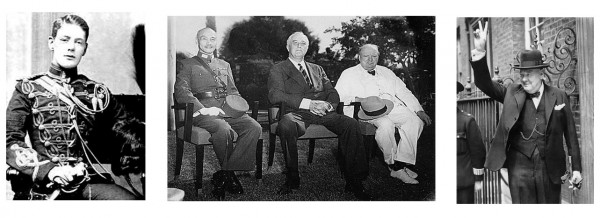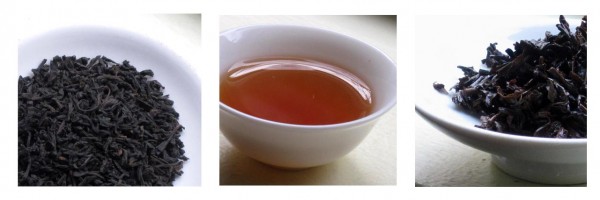

Pillars of Smoke: Churchill, Cigars and Lapsang Souchong Tea
Figure of a Man
It is curious the inspirations that draw me to a topic for a post. While cleaning some shelves recently, I reaquainted myself with a vintage carved wooden figure of Winston Churchill, purchased when my mother and grandmother cruised the Saguenay River, Quebec, towards the end of WWII. In this carving by a Swedish artist named Trygg, “Winnie” is wearing a morning suit with top hat and is smoking the ever present cigar. The fact that my family chose to purchase this memento on a trip to Quebec speaks to Churchill’s popularity at the time. The 1940’s souvenir seems to capture his character and stance – one hand at his side the other behind his back. As I stared at the small effigy I had a desire to photograph ‘him’ and wondered how I could work it into a post about tea. I remembered that Churchill had a favourite tea – Lapsang Souchong – so there you have it. I believe you can find connections between tea and most subjects, but in this case it was obvious.
I have learned through researching this post that not only was Winston Churchill (1874 – 1965) a great orator, politician and war time leader, he was also such a talented writer that he was able to support his lavish lifestyle through writing. His memoirs, volumes of history and dispatches while on assignment for major newspapers, were well received in their time and valued today. He was a talented painter and was a proud member of the Bricklayer’s Union (he built a brick wall and other brick features at his home, Chartwell). He was even somewhat of an innovator style-wise. He had a “siren suit” made for his war room headquarters. If he needed to leave quickly, he could just zip on the pin striped boiler suit style garment. He also had one made up in red velvet!
He had a fondness for Johnnie Walker Red Label, Champagne Pol Roger and Lapsang Souchong 正山小种 tea. Churchill probably drank the smoky tarry deliciousness because it could stand on its own beside the real smoke of his ever-present Cuban cigars. He was introduced to cigars as a young man on assignment for the Daily Graphic in Cuba, 1895, covering the guerilla uprising against the Spanish. From that point on, Cuban cigars became an ever present part of his daily life – there are few photographs where he is not holding or puffing on one. He had 1,000 carefully stored in his humidor at Chartwell, home for 40 years. Romeo y Julieta was his favourite brand and he always presented an open box for his guests. He smoked 10 a day, although they would often go out due to distractions and were left unlit or rarely finished. Smoky air and smoky tea mingled to create a rich almost campfire-like smell that must have been reminiscent of his early years as an army officer in the Sudan and Boer Wars. With this preference for life and work enveloped by the smoky aroma of his beloved Cubans, it is no wonder that he loved Lapsang Souchong tea.

From left to right, A dashing young Churchill in military uniform of the 4th Hussars, taken in 1895 the year he reported from Cuba: Meeting in Cairo, 1943 with Chiang Kai-shek and Franklin D. Roosevelt: Churchill outside Downing St., 1943, giving his famous V for Victory sign. The ubiquitous cigar present in his left hand. (All Public Domain) Smoking out a Winner
The origin of Lapsang Souchong, 正山小種 is also associated with war. There are several versions of the story, but each involves a prematurely halted processing of black tea, bohea class. In China, sometime during the Qing dynasty (1644 – 1912) invading troops marched into the tea producing area of the Wuyi Mountains of Fujian province. One version suggests the area itself was under attack, another that the troops required accommodation and for this purpose took over a tea factory. Some speculate that the tea producer was forced to either abandon his tea factory or bury his tea. All accounts discribe a distraught tea farmer returning many days later to discover his ruined tea and resorting to extreme measures to save it. In one tale he dried the damp tea quickly over an intense pine fire. In another version the tea that had been abandoned on the factory racks, absorbed excess pine smoke brought about by the smoldering factory ovens that the army used to keep warm. Either way, the farmer thought his tea was ruined by the smoke but to his astonishment discovered that the Dutch tea merchants loved it, were willing to buy it and returned wanting more.
Imposters, Charlatans and Originals
Authentic Lapsang Souchong, called Zheng Shan (Original Mountain) Souchong comes from Tong Mu Guan in Xing Village, Wuyi Mountains, Fujian. Other areas of Fujian outside this village produce Lapsang but connoisseurs argue that in this case terroir is an influencing factor in the taste of the final product. The local pine of Tong Mu has a particularly strong pitch which creates a unique and strong smoke. There is a proliferation of charlatan Lapsangs that claim to be smoked but in fact have had liquid smoke sprayed on them during processing. This is probably, I’m sorry to say, what most people have in their cupboards. Xing village producers are very secretive of their processing techniques, but some steps are known. Real Lapsang Souchong gets its heady smokiness from a rather laborious finishing process. The withered and oxidized leaf is layered on multiple bamboo storeys. Indigenous pine is burned in central ovens and smoke is sent curling through the layers. It is rather scarce on the market and most retail prices reflect this.

Lapsang Souchong: dark tarry dry leaf, red amber liquor and rich dark wet leaf You can find authentic Tong Mu Lapsang Souchong at Tao Tea Leaf. They also sell a “new style” LS which is not as smoky. I chose the traditional style. As you can see from the pictures above, the dry leaf is a matte black and appears twisted and curled. It smells strongly of pine smoke.
- Using 3g of dry leaf for a 6oz vessel I infused the leaf with boiling water for 3 minutes.
- The liquor was clear and amber red in colour.
- The taste was obviously smoky, but after a second infusion, a fruity dark berry taste was present.
- The broken wet leaf is very shiny and dark walnut in colour.
- Would pair nicely with creamy or mild cheeses such as Brie, Camembert or Emmental
When presented with the dry leaf from an open bag there is a moment where a tea drinker will either dive in or pivot away from the experience. I’m not sure why the smoky aroma is so evocative, but some people have a negative association with it. I came to LS long before I discovered that I shared that in common with Winston Churchill. My mental connection with Lapsang Souchong is a pleasant one – I am transported to Northern Saskatchewan and campfires under the dramatic blast of Aurora Borealis. I only drink it half a dozen times a year, usually in the winter when here in Canada we tend to be stuck indoors. Now when I sip it I will also think of Winston and my new found fascination with his life. Here are some classic Winston Churchill quotes:
“Eating words has never given me indigestion.”
“The farther backward you can look, the farther forward you are likely to see.”
“Out of intense complexities intense simplicities emerge.”
Are you a Lapsang Souchong fan? What does it evoke when you drink it? Do you think it is preferred more by men than women? Do you have any theories? Leave a comment so we can continue the discussion.


